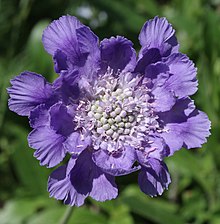| Lomelosia caucasica | |
|---|---|

| |
| Lomelosia caucasica (syn. Scabiosa caucasica) | |
| Scientific classification | |
| Kingdom: | Plantae |
| Clade: | Tracheophytes |
| Clade: | Angiosperms |
| Clade: | Eudicots |
| Clade: | Asterids |
| Order: | Dipsacales |
| Family: | Caprifoliaceae |
| Genus: | Lomelosia |
| Species: | L. caucasica |
| Binomial name | |
| Lomelosia caucasica (M.Bieb.) Greuter & Burdet | |
| Synonyms | |
| |
Lomelosia caucasica, the Caucasian pincushion flower, pincushion-flower or Caucasian scabious, is a species of flowering plant in the family Caprifoliaceae, native to the Caucasus, north eastern Turkey, and northern Iran. Growing to 60 cm (24 in) tall and broad, it is a clump-forming perennial with grey-green, divided leaves. Pincushion-shaped buds, borne on erect hairy, stems, open to pale blue or lavender flower heads, 4–8 cm (2–3 in) in diameter, from late summer through to autumn.
It was formerly known as Scabiosa caucasica until 1985, when it became Lomelosia caucasica. It is still listed in some sources as Scabiosa caucasica.
Taxonomy
After a study of the family Dipsacaceae (by Verlaque 1983), the Scabioseae were then split into several genera, with S. caucasica placed in Lomelosia Raf. (Greuter 1985). Further carpological (study of fruit and seeds) and palynological (dust study) studies (Mayer & Ehrendorf er 1999) have further confirmed this view, which has then been further substantiated by more recent data from molecular phylogenetics (Caputo & al. 2004; Avino & al. 2009).
The GBIF, and United States Department of Agriculture and the Agricultural Research Service, agreed to the name change.
Ecology
The plant is highly attractive to bees and other pollinating insects.
Cultivars
Numerous cultivars have been developed for garden use, in shades of red, purple, pink, blue and white. The cultivars of 'Clive Greaves', (large, lavender blue), and 'Miss Willmott', (white with tall stems) have gained the Royal Horticultural Society's Award of Garden Merit.
Other cultivars include:-
- 'Blue Perfection' (blue)
- 'Bressingham White' (white)
- 'Claire Greaves' (lavender blue)
- 'Compliment' (large blue)
- 'Fama' (large lavender blue)
- 'Floral Queen' (light blue)
- 'Loddon White' (white)
- 'Moonbeam Blue' (dark blue)
- 'Mrs Isaac House' (creamy white)
- 'Perfecta' (dark lavender blue)
- 'Perfecta Alba Blanc' (white)
- 'Staefa' (blue)

References
- "Lomelosia caucasica (M.Bieb.) Greuter & Burdet | Plants of the World Online | Kew Science". Plants of the World Online. Retrieved 18 August 2022.
- NRCS. "Scabiosa caucasica". PLANTS Database. United States Department of Agriculture (USDA). Retrieved 6 November 2015.
- BSBI List 2007 (xls). Botanical Society of Britain and Ireland. Archived from the original (xls) on 2015-06-26. Retrieved 2014-10-17.
- RHS A-Z encyclopedia of garden plants. United Kingdom: Dorling Kindersley. 2008. p. 1136. ISBN 978-1405332965.
- ^ Lack, H. Walter (17 July 2018). "The discovery and naming of Lomelosia caucasica (Dipsacaceae) with notes on its nomenclature and its early cultivation". Willdenowia. 48 (2): 185–194. doi:10.3372/wi.48.48202. S2CID 91252940.
- ^ James Cullen, Sabina G. Knees, H. Suzanne Cubey and J. M. H. Shaw (editors) The European Garden Flora Flowering Plants: A Manual for the Identification ... (2011), p. 360, at Google Books
- Greuter W. & Raus Th. (ed.), Med-Checklist Notulae, 11. — Willdenowia 15: 61–84. 1985
- Caputo P., Cozzolino S. & Moretti A. 2004: Molecular phylogenetics of Dipsacaceae reveals parallel trends in seed dispersal syndromes. — Pl. Syst. Evol. 246: 163–175.
- Avino M., Tortoriello G. & Caputo P. 2009: A phylogenetic analysis of Dipsacaceae (Dipsacales) based on four DNA regions. — Pl. Syst. Evol. 279: 69–86.
- "Lomelosia caucasica (M.Bieb.) Greuter & Burdet". www.gbif.org. Retrieved 19 August 2022.
- "Lomelosia caucasica (M. Bieb.) Greuter & Burdet GRIN-Global". npgsweb.ars-grin.gov. Retrieved 19 August 2022.
- Bourne, Val. "Telegraph - how to grow - Scabiosa caucasica". Retrieved 3 June 2013.
- "RHS Plant Selector - Scabiosa caucasica 'Clive Greaves'". Retrieved 5 March 2021.
- "RHS Plant Selector - Scabiosa caucasica 'Miss Willmott'". Retrieved 5 March 2021.
- "AGM Plants - Ornamental" (PDF). Royal Horticultural Society. July 2017. p. 95. Retrieved 4 November 2018.
Other sources
- Botanica, Einjährige und mehrjährige Pflanzen, Über 2000 Pflanzenporträts, ISBN 978-3-8331-4469-1, paĝe 790 (German)
| Taxon identifiers | |
|---|---|
| Lomelosia caucasica | |
| Scabiosa caucasica |
|
This Dipsacales article is a stub. You can help Misplaced Pages by expanding it. |